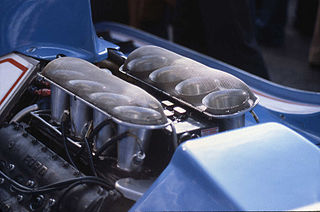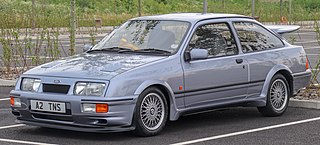
Cosworth is a British automotive engineering company founded in London in 1958, specialising in high-performance internal combustion engines, powertrain, and electronics for automobile racing (motorsport) and mainstream automotive industries. Cosworth is based in Northampton, England, with facilities in Cottenham, England, Silverstone, England, and Indianapolis, IN, US.

A four-wheel drive, also called 4×4 or 4WD, is a two-axled vehicle drivetrain capable of providing torque to all of its wheels simultaneously. It may be full-time or on-demand, and is typically linked via a transfer case providing an additional output drive shaft and, in many instances, additional gear ranges.

The DFV is an internal combustion engine that was originally produced by Cosworth for Formula One motor racing. The name is an abbreviation of Double Four Valve, the engine being a V8 development of the earlier four-cylinder FVA, which had four valves per cylinder.
Marco Apicella is an Italian former professional racing driver. He competed in one Formula One Grand Prix for the Jordan team in the 1993 Italian Grand Prix. He later won the 1994 Japanese Formula 3000 Championship driving for Dome.

The 1971 Italian Grand Prix was a Formula One motor race held at Monza on 5 September 1971. It was race 9 of 11 in both the 1971 World Championship of Drivers and the 1971 International Cup for Formula One Manufacturers.
Connew Racing Team, commonly known as Connew, was a short lived British Formula One constructor. Founded in 1971 by Peter Connew, the team constructed a single car, the PC1. The first monococque had to be aborted due to a change in regulations and the second tub was known as PC2. However, record books show the car driven by Migault and others as PC1. The intent was to compete in the Formula One World Championship in 1972, but a lack of financial and technical resources meant that the car only managed to start in one championship race, the 1972 Austrian Grand Prix, with French driver François Migault at the wheel. Following the Austrian race, the car competed in a handful of non-championship races before being converted to meet Formula 5000 specifications for the 1973 season. The chassis was damaged beyond repair during the season finale at Brands Hatch and the team closed.

Kauhsen was a Formula One constructor from Germany, founded by former sportscar driver Willi Kauhsen. The team started in Formula Two in 1976, purchasing Renault cars, and raced with an assortment of drivers with limited success. Kauhsen then entered the 1979 Formula One season, spending 1978 designing their own chassis with Cosworth engines. They participated in two World Championship Grands Prix with Gianfranco Brancatelli, failing to qualify on both occasions, before the team was shut down.

The Ferrari 312T was a Ferrari Formula One car design, based on the 312B3 from 1974. In various versions, it was used from 1975 until 1980. It was designed by Mauro Forghieri for the 1975 season, and was an uncomplicated and clean design that responded well to mechanical upgrades.

The Williams FW07 was a ground effect Formula One racing car designed by Patrick Head, Frank Dernie, and Neil Oatley for the 1979 F1 season.

The Brabham BT49 is a Formula One racing car designed by South African Gordon Murray for the British Brabham team. The BT49 competed in the 1979 to 1982 Formula One World Championships and was used by Brazilian driver Nelson Piquet to win his first World Championship in 1981.

The March 2-4-0 was an experimental six-wheeled Formula One racing car built by the March Engineering company of Bicester, UK. It was constructed in late 1976 and tested in early 1977.
Team Haas (USA) Ltd., sometimes called Beatrice Haas after its major sponsor, was an American Formula One team founded by Carl Haas in 1984 after an agreement with Beatrice Foods, a US consumer products conglomerate, which competed in the World Championship from 1985 to 1986. An agreement to use Ford engines for three seasons faltered after a change of management at Beatrice. The firing of Beatrice CEO Jim Dutt led to Beatrice withdrawing their funding of the project. The team was unable to continue in Formula One after the 1986 season. 1980 World Champion Alan Jones was coaxed out of retirement to drive the team's first car at the end of the 1985 season and on into 1986. Future prestigious designers Ross Brawn and Adrian Newey passed through the team.

The McLaren M2B was the McLaren team's first Formula One racing car, used during the 1966 season. It was conceived in 1965 and preceded by the M2A development car. Designed by Robin Herd, the innovative but problematic Mallite material was used in its construction. The car was powered by Ford and Serenissima engines but both lacked power and suffered from reliability issues.

The McLaren M7A and its M7B, M7C and M7D variants were Formula One racing cars, built by McLaren and used in the world championship between 1968 and 1971. After two relatively unsuccessful years of Formula One competition, the M7A was used to score McLaren's first win at the 1968 Belgian Grand Prix.
Four-wheel drive (4WD) has only been tried a handful of times in Formula One. In the World Championship era since 1950, only eight such cars are known to have been built.

The BRM P67 was an experimental Formula One car, designed by Tony Rudd and built by the British Racing Motors team in Bourne, Lincolnshire, England, for the 1964 Formula One season.

The Ford Sierra RS Cosworth is a high-performance version of the Ford Sierra that was built by Ford Europe from 1986 to 1992. It was the result of a Ford Motorsport project with the purpose of producing an outright winner for Group A racing in Europe.

Robert John "Robin" Herd was an English engineer, designer and businessman.

The March 701 is a Formula One racing car model, designed by Robin Herd with Peter Wright, and built by March Engineering. The 701 was March's first Formula One design – following their one-off March 693P Formula Three prototype of 1969 – and was designed and built in only three months. The March 701 made its race debut a month after its public unveiling, at the 1970 South African Grand Prix. In total, eleven 701s were constructed, with March supplying many privateer entrants as well as their own works team. The 701's career started well, March drivers taking three wins and three pole positions from the car's first four race entries, but lack of development through the 1970 Formula One season resulted in increasingly poor results as the year wore on. The 701 was superseded by the March 711 in 1971, and made its last World Championship race appearance at the 1971 Italian Grand Prix.

The March 721 is a Formula One car, designed, developed, and made by March Engineering for the 1972 Formula One season. It was powered by the 3.0 L (180 cu in) Ford-Cosworth DFV engine. It was driven by Ronnie Peterson, Niki Lauda, Henri Pescarolo, Carlos Pace, and Mike Beuttler.















